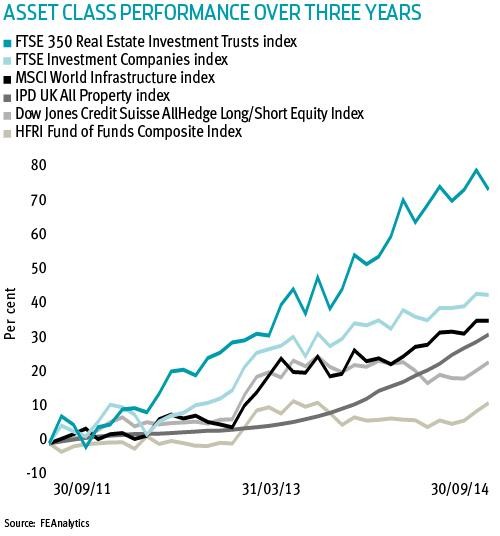Multiasset managed funds come and see the real thing
Post on: 30 Июнь, 2015 No Comment

In 2014, investor appetite for multi-asset strategies has remained at elevated levels, as evidenced by the significant flow of funds into this sector.
Growth in funds under advice has been matched by a proliferation of new offerings, particularly in the “real return” market segment, as investment managers respond to the segment’s emerging status, whilst also seeking to emulate the success of longer-standing market participants.
This trend is expected to continue in the near term due to favourable market dynamics born out of legislative reform and an ever-evolving investment landscape. The hypothetical merit of real-return funds has been well publicised in recent times.
However, it is not clear if prospective investors are equally informed as to the risks embedded in many of these strategies. These risks can be significant and may result in more variable investment returns. For this reason, it is important for investors to remain diligent in their assessment of real-return strategies, with the belief that a more informed understanding may aid them in determining which strategies are most suitable, given their tolerance for risk.
- See Also: Top fund managers recognised in the
Relative appeal
There are many reasons why investor demand for real-return funds has continued to grow. Core amongst these is the belief that they have been structured to overcome some of the limitations posed by their more traditional strategic asset allocation (SAA)-based counterparts.
Namely, real-return funds are better placed to respond to an ever-dynamic investment landscape, owing to the absence of a predefined asset mix that dictates portfolio positioning. Instead, managers of real-return funds are commonly granted significant latitude to alter asset allocation in response to changing market conditions and risk/return expectations.
Proponents argue that through this less constrained approach, real-return funds are better positioned to take advantage of market mispricings, whilst also steering clear of overvalued asset classes. It is important for investors to note that a real-return fund’s asset mix may vary materially from one period to another, with the potential for concentrated exposures that may be retained for extended periods.
Prospective investors must also be willing to accept that this adjustment process may be frequent as investment managers strive to generate absolute returns, regardless of market conditions, whilst also placing significant emphasis on downside protection.
Product nuances
While the investment case for real-return funds remains strong, particularly when considered in light of the ever-dynamic nature of global markets, investors should be aware that not all funds within this market segment are the same. Product nuances exist, and a greater appreciation of these may aid investors in better understanding the spread of investment outcomes likely to be observed across this space in years to come.
Three areas of difference are commonly observed across competing real-return strategies:

1. Reference benchmark
Real-return funds often reference “inflation” (or “cash”) as part of their stated benchmark. An issue, however, is that across this market segment, a uniform measure for inflation (and cash) has yet to be adopted for performance-reporting purposes. This can be evidenced by the range of reference benchmarks sighted across the space, including CPI (trimmed mean), CPI (all group), RBA cash, and bank bills. In the absence of such a uniform measure, it is feasible that funds with consistent mandates, investment terms and targeted returns deliver competing outcomes owing to performance differences observed across varying reference benchmarks (and the associated compounding effect through time).
2. Targeted margin
Common to all real-return funds is the desire of segment participants to generate absolute returns, over the longer term. A key area of difference exists, however, concerning the degree to which investment managers seek to generate a return in excess of inflation (or cash). Generally, the greater the degree of outperformance targeted by managers, the more likely they are to employ a range of extension strategies (such as leverage, shorting and the incorporation of illiquid exposures), which may in turn contribute to a more variable path of investment outcomes.
3. Structure
Owing to the greater interest shown by investors in real-return funds, there has in recent times been a growing presence of global strategies being offered to market. This has been particularly evident across those global managers that have an established capability, with considerable scale and strong performance track record. For those investment managers fortunate to be in this position, many have been keen to offer a cost-efficient mechanism through which $A investors may gain exposure. Increasingly, this has been achieved through the adoption of a less traditional feeder-fund structure.
While a detailed synopsis of feeder-funds remains outside the scope of this article, it is important for prospective investors to note that owing to this structure, it is feasible that $A investors achieve an investment outcome that is different from that of the global master fund. This may be due to factors including hedging mismatch, benchmark misfit and cash drag.
This article has put forward some arguments in support of real returns. It has also been suggested that favourable market dynamics exist, which are likely to perpetuate their “in vogue” status. However, prospective investors must be aware that a number of strategies offered within this discrete market segment have relatively short performance track records and have yet to be tested across the course of a full market cycle.
Furthermore, investors are cautioned to ensure that due consideration is given to the risks embedded in these funds, together with product nuances which can alter longer-term investment outcomes.














